Next week at the ABC Children’s Institute in San Antonio, I’ll be on a panel with fellow booksellers and one librarian, talking about our experiences with adult customers and patrons who seem to be pushing children out of picture books and into chapter books at younger and younger ages.
I don’t want to post spoilers for the panel (I’ll report on the discussion next week, and I think ABA members will be able to watch the video of the panel), but I did want to ask you out there in ShelfTalker land — you parents and teachers and booksellers and librarians — if you are noticing this pressure, and why you think it’s happening. We don’t see this “age compression” in schools; teachers who shop at our bookstore seem to understand the value of both fiction and nonfiction picture books for students of all ages. But parents and grandparents seem to be balking.
Obviously, we need to educate customers about the richness of picture book language, and the huge range of styles and formats and narratives in this literary genre that is perhaps more diverse than any other. We need to remind them that, although the price of a 32-page picture book and a 300-page chapter book might be roughly the same, a child may read the chapter book once, but the picture book 1,000 times, finding more to discover with each reading.
Why do so many parents and grandparents reject even sophisticated picture books as “baby books?” Is it a misunderstanding of what picture books are? It is an outcome of the excesses of our testing-burdened, measurable-achievement-oriented educational system? Or is there a greater loss at work, as well? Has the love of stories become somehow lesser? Do we value only what is perceived as more challenging, and testable? And why is it that the same parents who readily read light, unchallenging books for their own pleasure and comfort don’t allow the same indulgence for their kids? They often want little Johnny or Samantha to chug on up the reading levels — again, a misperception, since so many picture books contain rich vocabulary and complex sentence structure that are more challenging than many young chapter books.
There is no sinister intent on these parents’ parts, of course; they are most likely simply trying to make sure their children are well prepared, not left behind, in the academic realm. So how do we best show them the sweet and rewarding light of opening their minds to the full range of worthy reading possibilities for their kids? Inquiring minds want to know — and if you share a terrific thought in the comments, I’d be delighted to share it during the panel discussion and credit you!
(Booksellers and librarians: The ABC has prepared a fantastic flyer to use, featuring great picture books to share with older kids, along with tips for talking with parents. Be on the lookout for that next week!)
Vermont’s Youngest Librarians (Ages 11 and 6)
Elizabeth Bluemle - March 31, 2014
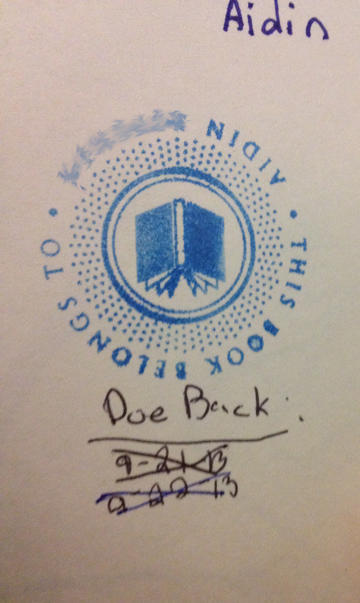 When I moved from New York City to Vermont, I had a little fantasy of finding a house that had its own library, a light-filled, high-ceilinged room lined with bookcases and windows, and at least two big window seats with cushions. I imagined pitchers of lemonade and an open-door policy for the neighborhood. I wanted to share my big collection of books with families, and I imagined letting people check them out with old-fashioned lined cards tucked in pockets inside each book. While my library fantasy turned into opening a bookstore, I recently met someone who had the same home library fantasy I did and made it come true. And he’s only 11.
When I moved from New York City to Vermont, I had a little fantasy of finding a house that had its own library, a light-filled, high-ceilinged room lined with bookcases and windows, and at least two big window seats with cushions. I imagined pitchers of lemonade and an open-door policy for the neighborhood. I wanted to share my big collection of books with families, and I imagined letting people check them out with old-fashioned lined cards tucked in pockets inside each book. While my library fantasy turned into opening a bookstore, I recently met someone who had the same home library fantasy I did and made it come true. And he’s only 11.
I met Aidin at the Flying Pig’s event for Jarrett Krosoczka a couple of months ago. He was waiting in the signing line with his parents and had a bright presence. He was one of those kids who seems remarkably easy in his own skin for such a young person: articulate, relaxed talking with adults and other kids, not shy. The kind of kid who grows up to be a political leader or who invents new ways for remote villages to gather water. At some point in the conversation with his family, it came out that Aidin had started a reading group last summer for his friends — around 15 kids, though not all of them come to the chapter-per-week discussions. One of his favorite book group picks so far was Brian Selznick’s The Invention of Hugo Cabret. He also turned his personal library of around 200 books into a lending library, and made and hand-delivered library cards for every kid in the neighborhood. His aunt had a special stamp made to mark his book’s endpapers, and Aidan uses that space to write due dates underneath the stamp.
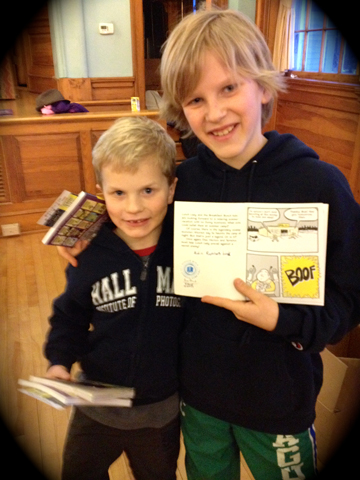
Vermont’s youngest librarians show off one of their newest acquisitions, Jarrett J. Krosoczka’s Lunch Lady and the Schoolwide Scuffle.
Because Aidin also has other goals he’s working on (he’s an athlete in training with his eye on breaking some records), Aidin’s younger brother, Foster, age 6, has also been pressed into service. According to the two kids, Foster is the library assistant, responsible for “bookkeeping, making sure the books are in good condition, that they come back in time, and that kids know the library policies about due dates and treating books nicely.” Wow. That’s quite a chunk of responsibility for a first grader, but it seems to be going smoothly so far. (Somehow it doesn’t surprise me that an older sibling already so adept at turning thoughts into actions is pretty good at knowing how to delegate. I had an older sibling just like that, and she is now executive director of an amazing nonprofit organization.)
I was so charmed and impressed by Aidin and Foster’s make-it-happen ingenuity. I hope their library continues to grow, that the reading group discovers ever more treasures, and that we get to see what other community-building schemes they cook up over the years.
Should We Lose the Bags?
Josie Leavitt - March 28, 2014
It is time to reorder bags. I find myself wondering if we should restock the ubiquitous shopping bag or not. Our bags are recycled kraft paper with soy based ink, so they’re about as eco-friendly as a bag can be, but the minimums per style are often huge. Yes, they are great advertisements for the store, but if no one uses one,I find myself wondering about the viability of keeping them.
It’s funny because I almost always want a bag when I’m shopping. My car tends towards messy and I usually park and walk, so I need to carry my purchases. But, the first place I shop tends to be the bag I use for my whole outing. I can hear folks yelling, “Bring your own bag.” I try to. I have bags literally looped on the front door knob, and even in the car, but I seem to never get myself together enough to actually have them with me when I need them.
Most of my customers are not like me. They come in, often with their Flying Pig tote bags (we give them away as premiums when folks spend $75 or more at one time, which happens a lot) or other reusable bags which they happily fill with books. More than likely, customers say no to a paper bag. I’m sure I’ve brought this up before, but some folks spend more time deciding if they want a bag than they do picking out their books. So, I find myself on the bubble about bags. If 90% of my customers don’t want bags, why do I keep paying for them?
I’m curious about how other stores, and customers, feel about bags. Are they obsolete or still a necessary part of doing business? Should we reorder, or not?
Putting Tintin into Historical Perspective
Josie Leavitt - March 27, 2014
Kenny Brechner of DDG Booksellers in Farmington, Maine, is guest blogging today. He is responding to a question posted on the NECBA listserv about censorship in the bookstore, specifically surrounding Tintin titles. I’m grateful to Kenny for sharing this with, as he dissects the issue clearly and cogently.
Bookstores are sometimes asked by customers to remove titles that the customer finds offensive. 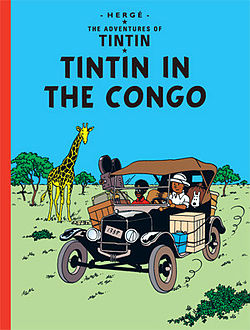 The classic graphic novel series by Herge, Tintin, garnered this unhappy attention recently at a friend’s bookstore. It is an interesting issue. Bookstores are not censors in the strict sense of the word, however to remove a book by virtue of an objection is certainly in that neighborhood. How to address this thorny situation?
The classic graphic novel series by Herge, Tintin, garnered this unhappy attention recently at a friend’s bookstore. It is an interesting issue. Bookstores are not censors in the strict sense of the word, however to remove a book by virtue of an objection is certainly in that neighborhood. How to address this thorny situation?
Sam Gamgee was of course mistaken in the “notion of his that the kindness of dear Mr. Frodo was of such a high degree that it must imply a fair measure of blindness.” I believe it to be of the first importance to be kind, but not blind to the embedded biases and prejudices we find in beloved literary works such as Tintin. The integrity of the present is dependent on the integrity of the past. We need to understand the complex dual historical continuum of enduring artistry and base cultural biases which are almost always intertwined. Herge’s Tintin in the Congo, which is not available in an edition for children in the United States at present, has long been cited as an example of unfiltered imperial colonial prejudices. For many of us it is certainly uncomfortable to see these elements mixed in with the familiar voice of a Tintin tale. The impulse to expunge rather than understand reinforces the very blindness it decries however. Recognizing the fallibility and bias of beloved works of literature is a matter for understanding not for removal, the impulse for which is quite as destructive as any embedded historical bias. Reading Tintin in the Congo offers us 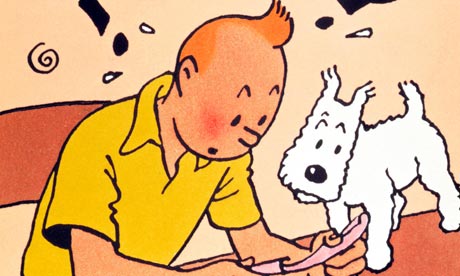 an opportunity to broaden our understanding and see our own world with clearer eyes.
an opportunity to broaden our understanding and see our own world with clearer eyes.
Herge’s Tintin in general contains many historical biases from his present. Are any of us free from biases that will be painfully apparent to the eyes of future generations? The Marx brothers were progressive and socially conscience. The inclusion of African-American actors and musicians in A Day at the Races was a progressive choice. Is it nonetheless rife with stereotypes that are painful to behold? Of course. Does that mean that children shouldn’t watch it or that the movie should be erased? Of course not. The fallibility inherent in the human condition is something to share and discuss with children, not shield them from, even as the enjoyment of classic works of children’s literature is something to share across generations. And that, my friends, is the discussion that needs to be had with our censorship-minded customers.
Food at the Bookstore
Josie Leavitt - March 25, 2014
I get a lot of comments on my lunches, or lack thereof. I’m not sure what happens that makes it so difficult to eat lunch at lunchtime when you work at a bookstore. I think it’s the timing of the book deliveries, or just that things get busy, or could be that I’m just too lazy to eat if it means breaking up my day.
Every store has a natural rhythm to its day. For us, from 10 to noon we get organized and shelve what didn’t get done the day before. Often this can mean being greeted by massive stacks on Tuesdays when the new books can find their rightful home on the shelf and not the back counter. The morning is also a good time to make phone calls. Also, because the mornings tend to be quieter than the afternoon, projects get worked on during this time. Emails get written as follow-ups to author event requests, school visits get organized, etc. The only thing that accompanies me on this is an iced double shot skim latte. I have this every day unless it’s 10 degrees or colder out. This drink is also known as a Josie at Village Wine and Coffee. And every day they draw my name of the cup in ever-increasing fanciful ways that make me smile.
Noontime rolls around and often I’m not hungry yet, so I just keep working. Then something bad happens around 2:30. I start to get a tiny bit cranky, just a bit, but enough that cold callers should be wary. Most of my ad reps know this about me and have smartly tend to come to the store in the morning. Frustration creeps in with small things, like damaged books caused by poor packing. The hassle of dealing with these on an almost daily basis (is it me, or are these happening more and more?) can seem far more irritating when my stomach starts letting me know it’s been far too long between meals. Around this time, I start foraging the back room for anything that constitutes food. We usually have nuts tucked around and in a pinch, they’ll do. I’ll sneak a peek in the fridge in the vain hope that the weak iced coffee I never drank has mysteriously thrown itself away. Sometimes, there’s cheese. Sometimes, that cheese is too nasty to even contemplate eating, let alone throw out (why we can leave office fridges in such states is beyond me, but I’m guilty of the closing the door and just hoping someone else throws it all away.)
Then around 3:30 or 4:00 the serious need for food has set in. I know now that if I don’t actually eat something with protein, bad things will happen. I remember a joke from Paul Reiser who said that he got a headache because he was too stupid to eat. I do this weekly. Finally, I sit down long enough to realize that I’m desperate for real food. Since the cafe next door closed, I now have to get in the car to get something. But because it’s so late, I get something small because dinner seems like it’s just around the corner. Often, I will find one or more of my staff hunched over a sandwich at three in the afternoon. They are usually standing at the desk or the counter, eating while they keep working. I’m sure this is against OSHA, but more booksellers don’t like to stop.
Sure, I could pack a lunch. But I just don’t cook any more. It’s time-consuming and annoying to cook for one, so I just don’t it much. Consequently, I have very little I can pack for a lunch. If I bring a yogurt in it’s a good day. Customers will sometimes bring food over. One customer owns a diner and every time she comes in I tease her about not bringing me a grilled cheese with tomato and bacon. Twice now, she’s brought me one and that has just made my day.
Booksellers, I’m very curious: how do you feed yourselves during the day?
Chats at the Bookstore
Josie Leavitt - March 24, 2014
The beauty of owning an independent bookstore is the depth of conversation I can have with customers. The level of comfort customers have with us, and us with them, allows for some lovely chats, often about serious things, that can had while discussing books. People often say that working retail means not knowing how your day is actually going to unfold because of who comes in the store and what they might need. And this is my favorite part of my job.
Below is a smattering of the conversations I had with customers last week.
– One woman came for the first time in many months and as we were getting caught up on her divorce and she revealed a scary accident that happened at home. She wasn’t going to go to the doctor to follow up on why she passed out for no reason. I strongly encouraged her to keep that appointment because I was worried about her heart. She hugged me and thanked me for encouraging her without totally terrifying her about her health. She called to say she has an appointment with a cardiologist this week and will keep me posted.
– Another woman, Isabelle, who comes in every Monday, seemed a little low and I just gave her a spontaneous hug. I’ve never hugged this customer before. She’s the most active 85-year-old I’ve met with more energy than most 20-year-olds but she just seemed like she needed a hug. She pulled back from the hug with damp eyes, and I asked if she was okay and she said that her sister had died the previous week. She then told me all about her and their lives. It was a wonderful talk that was full of laughter and more than a few tears.
– Lauren, who comes in three times a week, has been filling us in on her quest to get a puppy that her children won’t be allergic to. She showed us pictures of the litter of puppies that her dog is likely to come from. We all weighed in on the cutest one and she will keep us posted. She also promised to bring the puppy in for weekly socialization.
– A boy, probably 10 or so, came in and as we talking about fantasy books he just offered, “I’m reading everything because I want to get in a good college.” I was taken aback, because 10 seems a little young to be thinking about college, and he could see the surprise on my face. He went on to explain that he knew he’d have to get a scholarship because college is so expensive. We talked about his long-term goals and how he’s saving all of his allowance to help pay for school. I offered him a job when he’s 14.
I have often said owning a bookstore is a lot like having a bar without the alcohol. People feel comfortable sharing. I think partly is because we’ve been around so long, we know folks and there’s a level of comfort with us. We’ve seen families grow, we’ve lost far too many people, and we get to share in the happiness. And that makes every day a chance at joy, and that is a wonderful way to work.
Welcoming Young Readers
Josie Leavitt - March 20, 2014
There are myriad ways that booksellers connect with customers. Most often we talk about books and why we like them or why we think they might like them. But when little kids come to the store chatting about books, that doesn’t really work. So, how to connect to the little ones? Well, by playing with them.
The fun of a bookstore with an enormous children’s section is the kids. They start shopping at the store soon after birth. We are often baby’s first outing and that sets the tone that bookstore is a fun place to spend some time. The beauty of a children’s store is that all of us on staff love kids. Even my high school senior staffer, David, has a genuine love of small kids, and went so far as to remark his first month working at the store, “Babies are fun.” Babies sense who automatically likes them just because they’re them, and parents pick up on this. If their child is welcomed and greeted at the bookstore, parents tend to think fondly of the store.
Whenever a baby comes in we all, in a polite and quiet way, go over and visit. Each of us tries in turn to get a smile or even a chuckle from the little one. This distraction is two-fold: one, it’s just fun for us, but secondarily, it allows the parent(s) a little time to relax in the store and browse. All of us are equally happy holding a baby while a parent finishes her transaction. I’ve been known to just hold someone’s baby for 10 minutes while she tries to get her book shopping done without distractions. This is not only great fun for me, but parents like it and not all stores welcome tiny people. Babies cry, sometimes incredibly loudly. Rather than acting like our eardrums are puncturing, we will go over and see if we can help get a smile out of the tot or just commiserate with the parents.
When the little ones are more mobile we play peek-a-boo and generally have fun with them. Toddlers love to come explore the back room and behind the counter. We’ll often turn around to find a tiny tot standing in the doorway of the back office just taking it all in. We pack a lot in there and truthfully, most kids have never seen such a busy room. There are kids who come to the store and know that we’ll always play with them and that’s not only fun, it’s good customer service.
We don’t clean up around kids, either. The way to make parents come back, time and again, to the store is by making their kids feel welcome. I have a game I play that Elizabeth taught me. Sometimes, the checkout process can be fraught because the kids have to have give up the books to get them scanned. On a side note, we’ll often teach the kids how to use the scanner and that definitely takes the sadness out of being rung up. Elizabeth’s game is very simple, but really fun. You guess how old the child is, but you guess outrageous numbers. You look right at the child and say, “How old are you?” Sometimes, they’ll answer, but if they don’t Elizabeth tries this fun twist, “Are you 17?” The child will shake his head no and smile. Then you change the number higher and then lower and then higher again. It’s silly and it’s fun. And then before you know it, the books are rung up, paid for and ready for little hands to hold. What we’ve done is now made the bookstore fun for the kids and as they get older this will only grow as they discover the joy of books.
And there’s nothing better than having a little kid ask a parent for a trip to the bookstore.
When Books Become Movies
Josie Leavitt - March 18, 2014
I can’t help but be curious how the Divergent movie is going be when it opens next week. I have not seen reviews yet, but judging from the increase in book sales last week, I have say people are getting excited. As a bookseller I love that the movie’s release is driving folks to the store; as a fan of the book, I can’t help but be nervous about the book’s adaptation.
When books get made into movies things change. Sometimes for the better, though this is rare. In fact the only time I think a movie has been better than the book was Ordinary People. Other than that, I usually leave the theater angry that so much has been left out or outright changed. There is a condensing of the book that has to happen, but often the parts that are left out were the ones that added richness to novel. Adapting a few hundred pages of a book into a something Hollywood thinks will work as a movie cannot be easy.
Customers are still mad at the changes in the Hunger Games films, although I thought they did a really good job of capturing the essence of the book. Same thing happened with Harry Potter, although the general consensus is those two franchises did a really good job of keeping the book’s integrity and not jettisoning the quiet moments that made the books so good. One thing that I’m really enjoying is the rush to read, or reread books “before the movie ruins it,” as several customers have said.
So, readers, I’m curious: what are some of your favorite movie adaptations, and which ones are your worst?
Genius Event Promotion Idea
Josie Leavitt - March 17, 2014
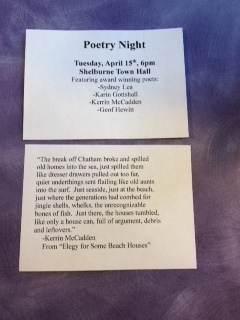 I left the store to run some errands yesterday, and when I got back I saw a great promo idea on the front counter created by our staffer Laura. We are having a stellar poetry event in April with four poets, including Vermont’s Poet Laureate, Sydney Lea. Laura, a poet herself, knows that most adults don’t generally read poetry, so she got really smart.
I left the store to run some errands yesterday, and when I got back I saw a great promo idea on the front counter created by our staffer Laura. We are having a stellar poetry event in April with four poets, including Vermont’s Poet Laureate, Sydney Lea. Laura, a poet herself, knows that most adults don’t generally read poetry, so she got really smart.
She’s created a simple bookmark that announces the event on one side and offers a poem on the other. Every week, she’ll feature another a different poet and one of their poems. She began this process by emailing each poet and asking for two poems that could be used for promotional purposes. All the poets have emailed back their selections and Laura is poised to change the bookmark every Monday until the event. Each poet will have their bookmark tucked in books and shopping bags until the event a month from now.
I must say, I’m not a poetry reader and I’m riveted by the first bookmark’s selection from Elegy for Beach Houses by Kerrin McCadden. Rich imagery coupled with a violent sea on the Cape make for a satisfying and compelling read. And that is precisely how these simple bookmarks are going to promote the event: they’re letting the poetry do the work by making the reader want to read more and meet the person who wrote it.
The Case for ‘The Case of the Marble Monster’
Elizabeth Bluemle - March 14, 2014
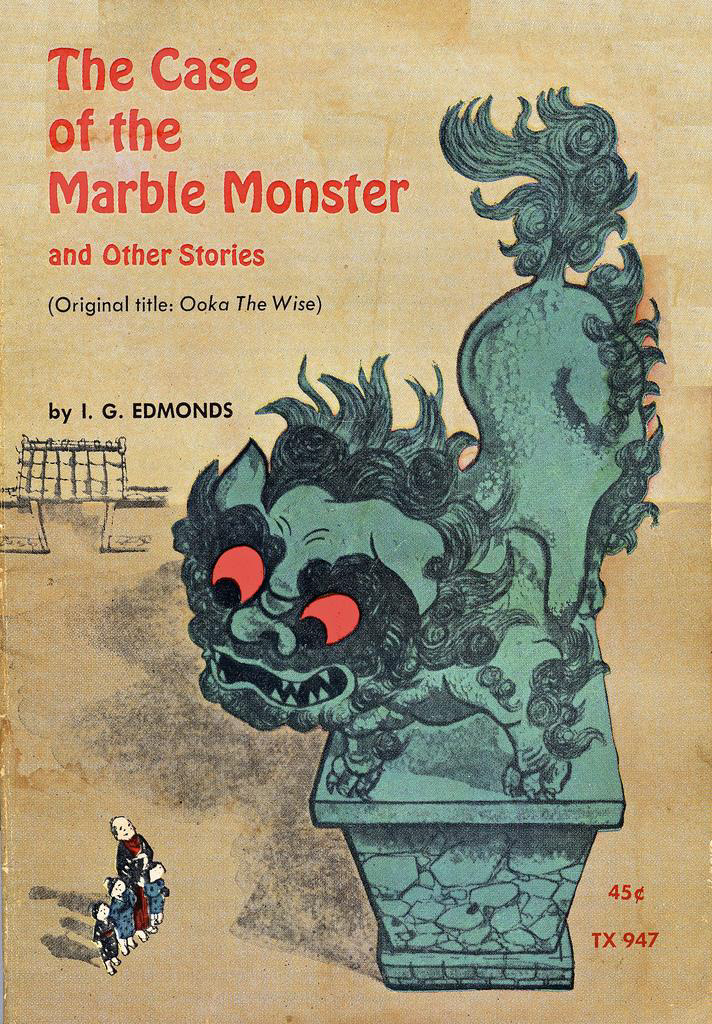 Of all the wonderful books I wish back in print, The Case of the Marble Monster by I.G. Edmonds is one of my very top picks. About the length of a Magic Tree House book, and aimed at about the same age (7-9, though older readers would also like it), this book contained 17 marvelous stories of the wise, kind, yet sly and often mischievous Judge Ooka and his many inventive solutions to perplexing problems, both large and small.
Of all the wonderful books I wish back in print, The Case of the Marble Monster by I.G. Edmonds is one of my very top picks. About the length of a Magic Tree House book, and aimed at about the same age (7-9, though older readers would also like it), this book contained 17 marvelous stories of the wise, kind, yet sly and often mischievous Judge Ooka and his many inventive solutions to perplexing problems, both large and small.
Each story has an evocative title, “Ooka and the Stolen Smell,” “Ooka and the Barbered Beast,” “Ooka and the Willow Witness,” “Ooka and the Death Decree,” and the stories themselves surpass the titles.
In the introduction, the author shares that he or she heard these stories from his or her own grandfather, Ojisan, on long winter nights in Japan. The author says that Judge “Ooka really lived, and he did some very strange things. He accused a statue of stealing some silk. He declared a student guilty of stealing a smell. He ruled that a man could be a thief and still be honest. He divided thirteen horses in two equal groups without cutting the thirteenth horse in two. And once he even sentenced himself to death! But all of the strange things he did were for the purpose of finding out the truth, so that he could carry out the shogun’s order to punish wickedness and reward virtue.”
Don’t you want to read the stories now, too? It’s like Encyclopedia Brown (without the ambergris). And yet both more delicate and more worldly.
I think what I loved so much about these stories when I was a child were not only the clever puzzles/paradoxes in the tales and their witty recounting, but also their gentle exploration of human character—with integrity, compassion, respect for others, and humor winning the day over greed, stubbornness, bullying displays of power, and other unsavory aspects of human nature. There’s a whole world of humanity, of heroes and villains, in this little book, from rich merchants to poor students, from small children to crafty con artists. There were kid problems and grown-up problems, all in the same book! It felt like a real world.
There’s something lovely about the fact that both author and illustrator hail from the Japanese culture, and that the author heard these stories from his or her nearly-90-year-old grandfather. I think that’s one of the reasons the book has such flavor and depth of texture even in its simplicity.
The illustrations throughout, by Sanae Yanazaki, are fantastic. I remember being fascinated not only by the various characters and their exotic (to me) silk robes and porcelain dogs and other accoutrements of life in long-ago Japan, but also by their similarity to myself and the people I grew up with in Scottsdale, Arizona, a place about as far from Ooka’s homeland as could be. This wasn’t a book that felt distant or alien; it was full of familiar notes and emotions, little kids who loved their puppies, fun and peppery grandparents, lively family gatherings, celebrations and festivals to look forward to. There was mystery and suspense and the huge satisfaction — 17 times! — of learning just how Judge Ooka would outwit the rogues and scoundrels who tried to lie, cheat, and steal.
I’ve re-read The Case of the Marble Monster several times over the years and find that it holds up beautifully. Simply told, with a rare quality of clarity, lightness, and charm, these stories are timeless. I don’t know if I.G. Edmonds ever wrote anything else, but he or she is a master storyteller, like Natalie Babbitt or Richard Peck — fluid, graceful, authoritative in the most invisible way.
My copy is from Scholastic Book Services which published it via an arrangement with Bobbs Merrill — which sounds as though it was one of my weekly book order treasures from the second or third grade. Regardless of who owns the rights at the moment, I just need to tell you publishers that this is the kind of book that kids eat up and adults find delightful. It invites all kinds of critical-thinking skills, too, in case someone (*coff*hello, Scholastic*coff*) wanted to reissue it with a school market in mind. If so, I hope they wouldn’t monkey with the text or art; it’s quite perfect as is.
So — my publishing pals, here it is, right in your laps: a perfect chapter book for that hungry young reader crowd. Aren’t you always telling me you want to find more of these? Today’s children need Judge Ooka! And so, come to think of it, do adults.
